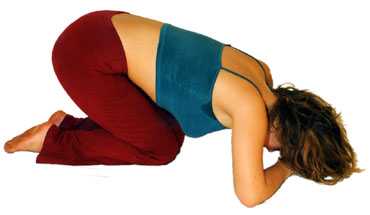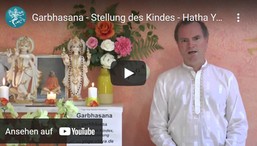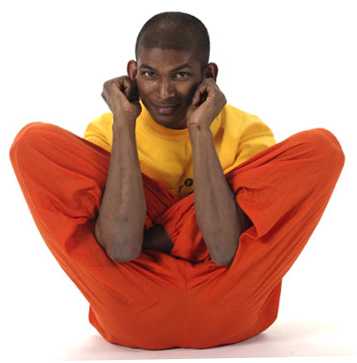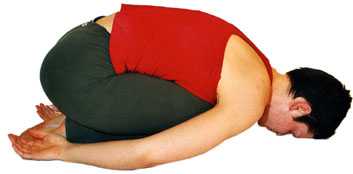

Balasana
«Balasana» the «Position of the Child» (Bala-Asana). When this Asana is performed, it resembles an embryo in the womb, hence it is also called «Embryo Position» («Garbhasana»).
Table of Contents
1 Balasana, the Position of the Child
2 Balasana — Advanced Variation
Balasana, Position of the Child
«Balasana» («Position of the Child») is the opposition to the «Headstand», the «Bow» and most «Backbends».
Technique
Sit on your heels, hands next to your feet, back of your hands on the floor. Let elbows hang down loosely. Forehead on floor, neck long. Shoulder blades hanging loosely; breathe deeply.
 Variation of the basic posture in case of insufficient flexibility
Variation of the basic posture in case of insufficient flexibility
If the flexibility in the knees is not sufficient, you can put your hands under your forehead. To do this, either put your hands flat on top of each other or make fists and put your fists on top of each other.
Effect
The «Balasana» is good for the whole spine on a physical level. The «Balasana» is especially good for the neck and cervical spine. The position stretches all back muscles and thus helps to release tensions. With the «Balasana» the muscles are stretched and relaxed, not strengthened. This allows the practitioner to relax completely.
In this gentle «Reverse Position» the blood circulation is activated. The abdominal organs receive a good massage. The «Position of the Child» helps to overcome nervous digestive problems and menstrual cramps, to cure stomach upsets, rheumatism and gastro-intestinal diseases.
On an energetic level, the «Balasana» activates the solar plexus and harmonizes the energies. The following Chakras are addressed: Manipura, Ajna, Sahasrara, Svadhishthana.
The embryo in the womb takes this position. The «Balasana» therefore helps to develop primal trust and humility as well as the ability to let go.
Contraindications: In all «Reversal Positions» one should be cautious or consult a doctor first if one suffers from retinal detachment and other serious eye problems or has severe hypertension.

 |
 |
Balasana, Advanced Variation
In his book «Yoga Asanas» Swami Sivananda explains the «Balasana» («Garbhasana»)) as follows:
TECHNIQUE
As described in the «Kukkutasana» bring both hands between thighs and calves. Push the elbows through as well. Then hold the right ear with the right hand and the left ear with the left hand. You should perform the last step of the Asana with great care. Because if you try to grasp the ears with your hands, you may fall backwards. You have no hands free to support yourself and you are helpless.
 Advanced Variation of «Garbhasana»
Advanced Variation of «Garbhasana»
But through practice you can slowly balance the body on the buttocks. The body will remain stable after a few days of regular practice. If you find it difficult to perform this Asana, you can practice it without the «Padmasana». Hold the ears or the neck by bringing the arms behind the thighs. In this modified position, the legs are stretched out downward. Stay in this position for 2 or 3 minutes. Repeat this 5 times.
EFFECT
The digestive power and appetite are stimulated. The bowel movement becomes free and regular. Many diseases of the digestive organs disappear. Arms and legs are strengthened.

 |
 |

